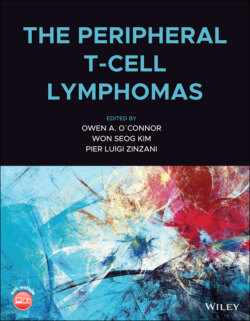Читать книгу The Peripheral T-Cell Lymphomas - Группа авторов - Страница 30
Genetic Alterations in the Angioimmunoblastic T‐cell Lymphoma Microenvironment
ОглавлениеRecent genetic studies at the single‐cell level have shed a new light onto the bystander cells in AITL. Since founding mutations in epigenetic modifiers have been found to occur in a hematopoietic CD34+ precursor or stem cell before lineage commitment [17, 31], TET2 and DNMT3A mutations can be detected not only in neoplastic T cells, but also in B cells isolated from AITL biopsies [71, 72]. Variant allele frequencies of TET2 and DNMT3A are usually higher than those of T‐cell restricted RHOA or IDH2 variants [14], indicating that epigenetic deregulation more widely affects the different cellular components of the tumors. Moreover, the B blasts, in addition to those infected with EBV, can show a restricted repertoire of hypermutated IG genes with destructive mutations [73], and may harbor additional somatic mutations, notably in NOTCH1 [72]. It is likely that this could hold true for reactive CD8+ T cells often abundant in AITL tissues and for mononucleate cells of myeloid lineage. In this respect, it is noteworthy that co‐occurrence of myeloproliferative disorders like acute myeloid or chronic myelomonocytic leukemia and AITL have been reported in some patients [74–76]. Both diseases may derive from a common ancestral progenitor harboring TET2 and/or DNMT3A mutations and/or high‐risk clonal hematopoiesis, with subsequently acquisition of distinct mutations initiating the divergent development of AITL and myeloid disease [75]. Altogether, these findings indicate that several components of the microenvironment can be genetically altered in AITL, and it is tempting to speculate that genetically altered bystander cells could also contribute to AITL pathogenesis (Figure 2.2). The role of EBV in this disease remains debated. It infects a variable number of large B blasts in around 80% of cases, with a latency type 2, but the question whether EBV has any oncogenic role or is present as a passenger, reflecting the immune defect observed in AITL, remains open. Indeed, transforming growth factor beta and IL10 produced by Tfh cells are known to suppress T‐cell responses by inhibiting the proliferation and function of conventional CD4 Th1 cells, and may play a role in the expansion of EBV‐positive B cells.
